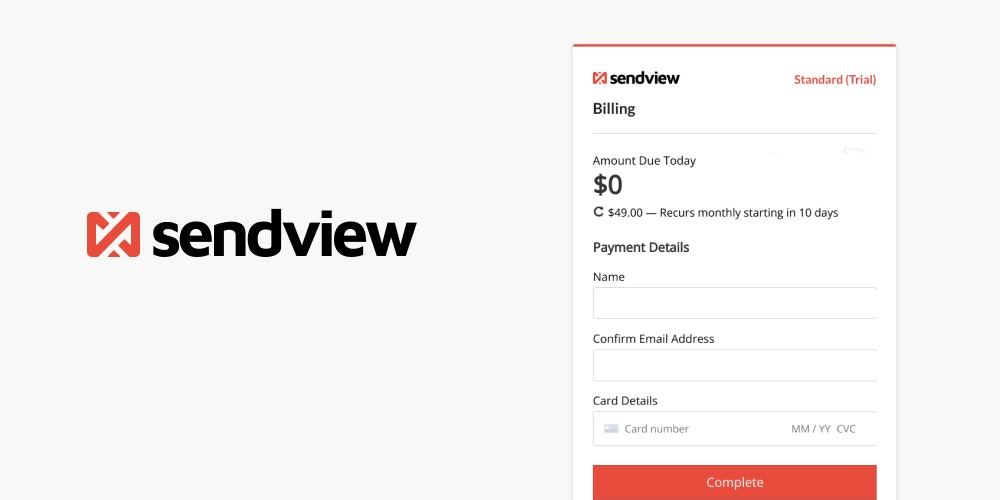Customers
How SendView Doubled Revenue 2 Years In A Row With MoonClerk
Dodd Caldwell
July 12, 2022

Gregg Blanchard, co-founder of SendView, talks with us about why he recommends MoonClerk to other indie-makers and side-hustlers and how MoonClerk helped him double revenue for his side project two years in a row.

Can you tell us a little about what SendView does?
Sure, SendView helps marketers track and learn from their competitors’ email campaigns.
What are your day-to-day responsibilities?
Primarily I’m the guy who writes the code, but I also share a bit of marketing and such with my co-founder, Patrick.
How did you get started?
I’d spent a number of years in the email marketing world. Unsurprisingly, I’d also subscribed to dozens and dozens of competitors and brands I admired hoping to learn from their tactics and strategies. But all I ever ended up with was a bunch more emails in my inbox that I never read.
At some point I started dabbling with the idea of routing these emails through some code first so I could save the results in the database as a side project. That way I could do analysis by writing SQL instead of manually copying/pasting stuff into spreadsheets.
One day in the summer of 2016 the lightbulb went on: with all this email data in my database, I could finally answer all the questions I was hoping to answer when I’d signed up for my competitors’ emails over the years. A few months later I had a proof of concept. I worked with some alpha users on it for a while before we went more public with it a little later.
What have been some key factors in growing your business?
This is a side-hustle for my co-founder and I, so one of the most important things is saving as much time as possible on things like dev, admin, overhead, etc. so we can have more time to focus on product work, marketing, and sales - the stuff that actually helps us grow. We really only put 3-5 hours a week each on this, so saving 10 hours is the equivalent of 2-3 weeks worth of work. Being really scrappy and intentional with our decision making has been key so we can stay focused.
Speaking of focus, that’s another point. We originally started with the idea that SendView would be part of a suite of products, but the numbers were so much better on SendView we eventually scrapped everything else. In hindsight, that focus was a game changer for us and our trajectory has been up ever since because we were only maintaining and marketing 1 product instead of 3.
What do you use MoonClerk for?
We use Moonclerk to handle all payments for the platform. I was studying the Stripe API and realizing that I could very well spend all my time just writing an integration that accounted for creating plans, changing plans, handling errors, retrying cards, sending emails, etc. To the point above, that level of effort could literally kill the project before it got off the ground given the limited time we had for it.
I wanted a platform that gave me an embeddable, customizable payment form and handled all the errors, emails, security, etc. but also had an API so I could make the process seamless for new users. I looked for weeks until I found MoonClerk and quickly realized it was exactly what I needed.
What problems did you have with your previous payment system?
I initially tried Gumroad but it lacked a solid API and the ability to match the form to my brand to make that sign up process seamless. It was close, but it was just a little too simple and their roadmap seemed to be focused on creators and one-time payments instead of people wanting to handle recurring billing for lots of customers.
How did these problems affect your business?
It made for a lot of manual work and confused users. Without a way to automatically move people from the payment page into a new account, I had to do a ton of handholding to help new users navigate a really unfamiliar signup flow. The payment form also didn’t match our brand and looked a little cheesy, which hurt our credibility and professionalism once we got in front of our target market of sophisticated email marketers and brands who were expecting a serious, polished app.
What made you finally decide to use MoonClerk?
Just realizing that it could do everything I wanted and I wouldn’t have to settle. With MoonClerk, I could customize the forms to perfectly match them to my brand, the API made signup and payment processing fully automated, and all the built-in stuff like notification emails and templates checked every box I had.
What was your experience when getting started with MoonClerk?
Amazingly fast. Seriously. I think I built the first integration and payment form in a couple hours one weekend. Granted, I had spent weeks reading docs from a lot of vendors and researching everything pretty closely, but it’s pretty remarkable how little code I’ve had to write on that onboarding flow once I made my choice. One of the things that really helped was the fact I could create an account and try it out before I started paying. I was ready to pay when I found the right tool, but that helped me confirm that the features listed on the sales page could do everything they promised.
What specific feature do you like most about MoonClerk?
Hosted, embeddable payment forms are my favorite feature of MoonClerk. Hands down. And it wasn’t just helpful initially, it’s been a priceless tool over and over again. For example, when we wanted to spin up a new plan for a few users who needed a unique payment schedule, we could. I just logged in, copied stuff over from another payment form, added a rule to our code to watch for this new payment form, and we were done in about 15 minutes. We didn’t have to say “no” to that revenue because of how many hours of dev work it might take to create a new, custom plan.
What are 2-3 other benefits of MoonClerk?
The API is something I use a lot. That has let me build automated invoice/receipt generation right into the app because I can call the API and get all the past payments for a user. The other benefit is being able to edit a customer’s plan after they sign up. We’ve had a lot of users sign up with a basic plan and move up and up to bigger and bigger plans. Being able to adjust their plan as needed no matter what the new monthly fee is, is again, something I would have spent way too much time writing my own code to create an interface and integration with Stripe’s API.
How has MoonClerk improved or helped your business?
There are two things I’d mention. The first is that I haven’t written more than a couple lines of payment-related code in a year. That frees up a ton of our limited time to focus on feature work and marketing that has been a key reason we were able to double Monthly Recurring Revenue in 2020 and then double it again in 2021.
The second is that with ACH and credit card payments available, almost 100% of our revenue is handled through Moonclerk (we have a couple users who insisted on using their accounting team’s invoicing tool). It’s hard to quantify how much time Moonclerk has saved me in dev time over the last 5+ years, but I’d wager it’s well over 100 hours.
Would you recommend MoonClerk to others? If so, why?
I would definitely recommend MoonClerk to others, and especially to indie makers and side hustlers. It’s an amazingly fast way to get your product to market and accept payments from day one. You can focus on building your product and then, in a single afternoon, get the payment stuff completely done. I wondered if we’d “outgrow” Moonclerk, but the opposite has been true. I’ve become more and more sold on it as we’ve grown because it lets me focus on making the product better instead of debugging payment issues.


